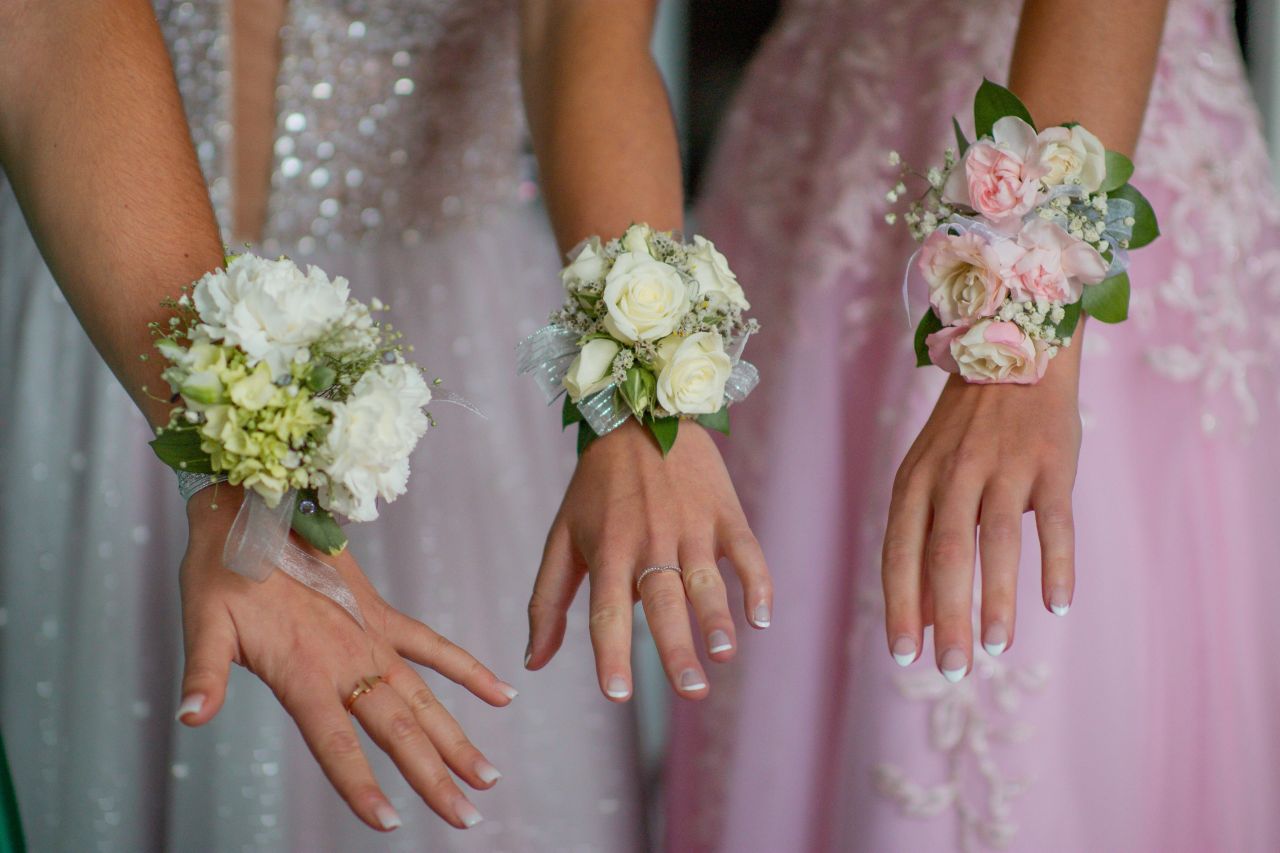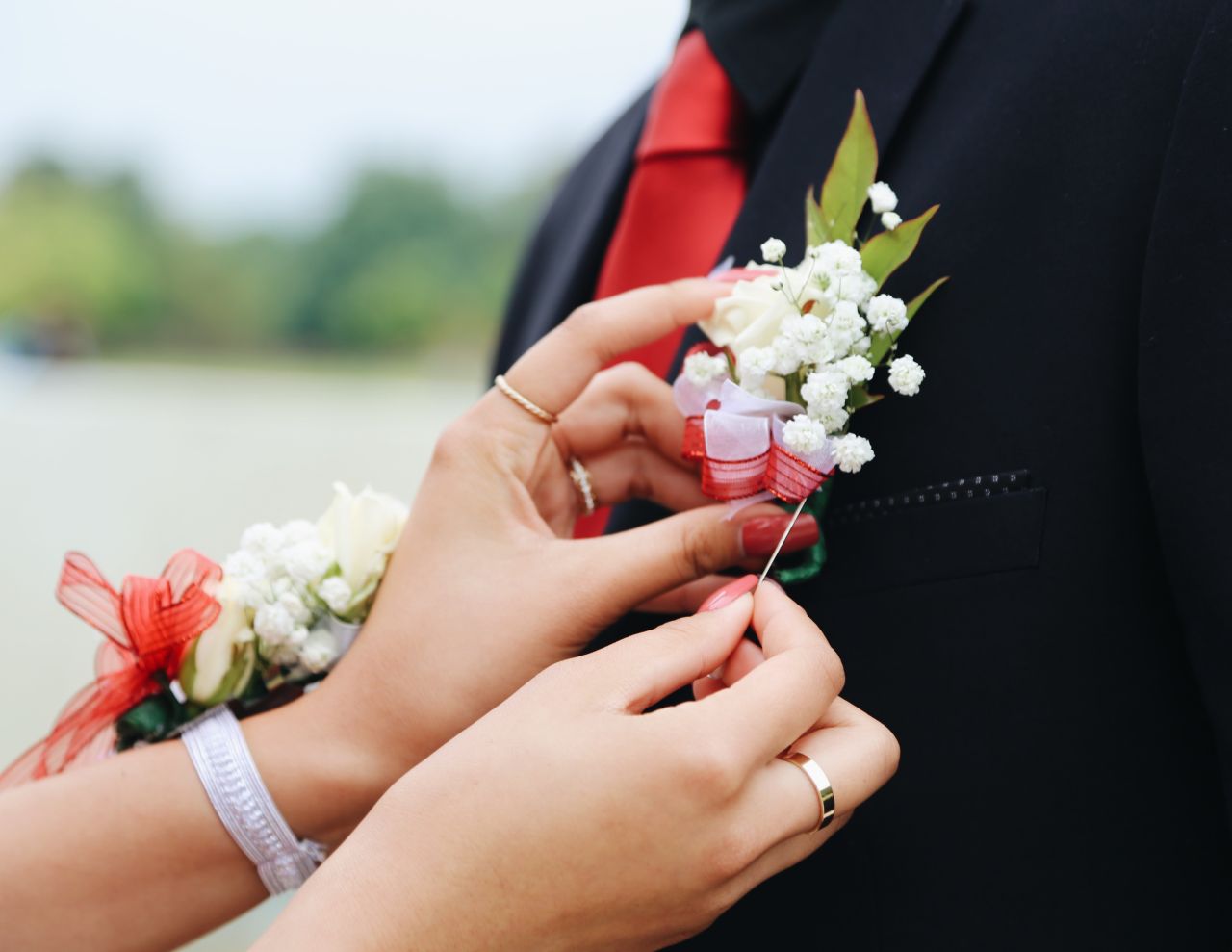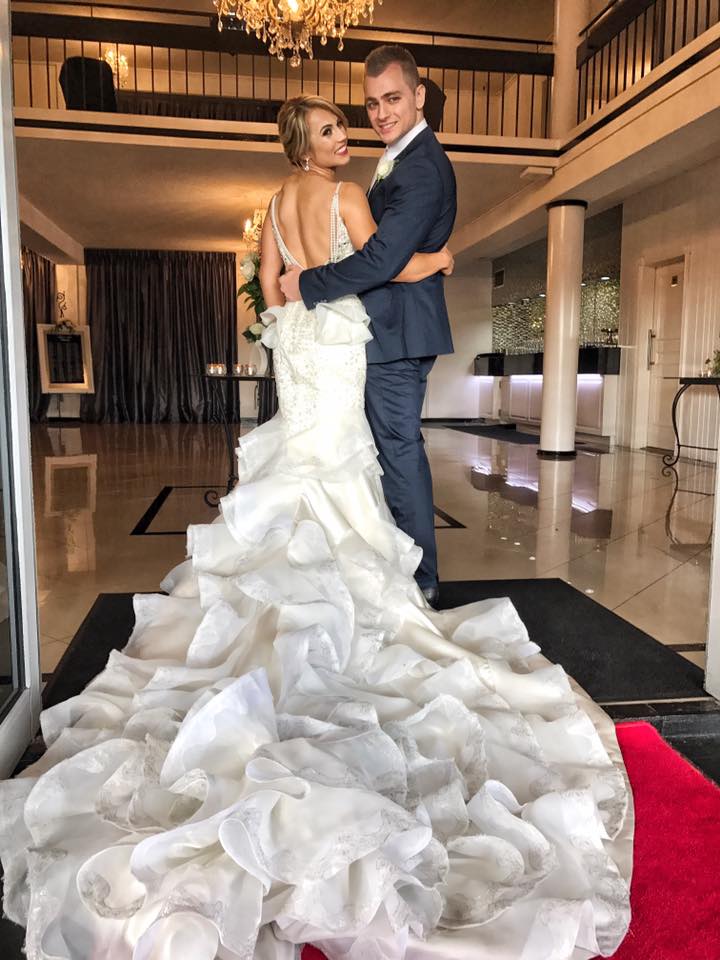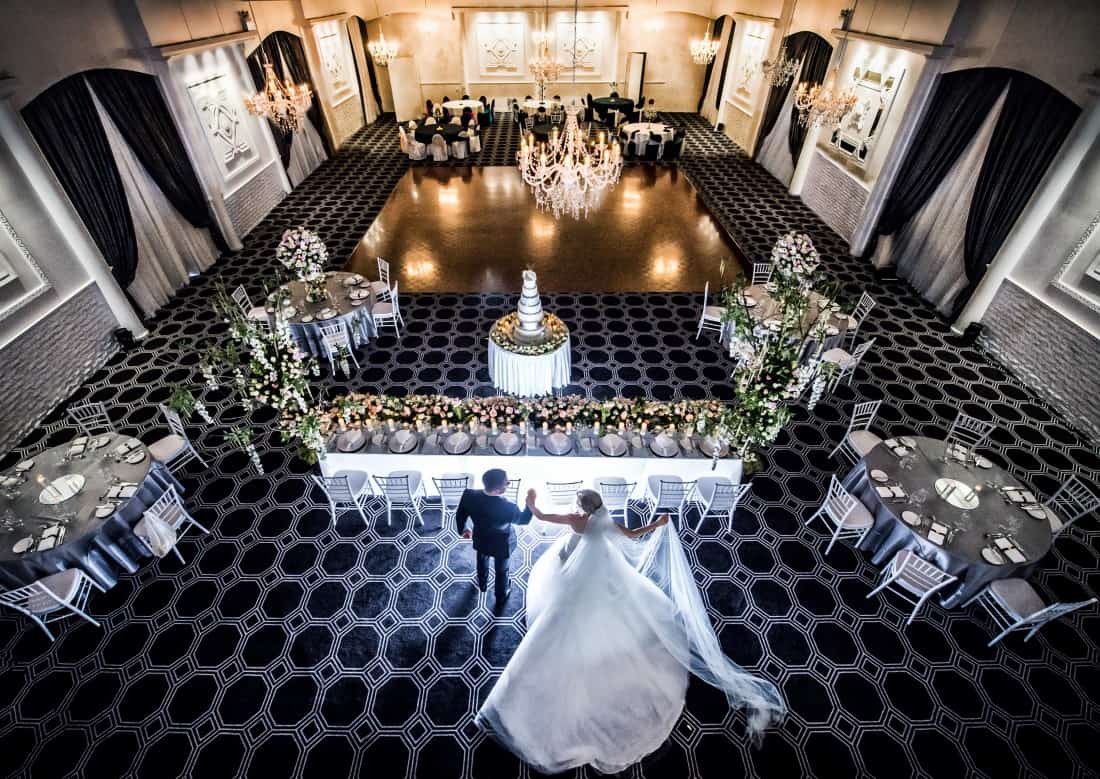When I got married at Vogue Ballroom, I never imagined that something as small as a wedding corsage could hold so much meaning. But as the day unfolded, I quickly realised that these little floral accessories are more than just decorations—they’re symbols of love, respect, and the bonds that tie us together.
A corsage, whether worn by the bride’s mother, a bridesmaid, or even a guest, has a way of making the wearer feel truly special. It’s a personal gesture that speaks volumes, adding elegance and significance to the day’s celebrations. And while the focus is often on the bridal bouquet, the humble corsage carries a unique symbolism that deserves a closer look.
From its rich history to the various styles and meanings behind different flowers, there’s a lot more to a wedding corsage than meets the eye. Whether you’re a bride, a member of the bridal party, or a guest, you’ll soon see why a wedding corsage is much more than just a floral accessory. Let’s take a closer look at what these timeless pieces really symbolise and how to choose the perfect one for your big day.
The Meaning Behind Wedding Corsages: More Than Just a Floral Accessory
When I worked with a couple from St Kilda, they were focused on the smallest details of their wedding—especially the flowers. Their wedding corsages weren’t just decorative; they were meaningful gifts for their closest family members and friends. It was a gesture that added another layer of appreciation to their special day.
Corsages as Symbols of Honour, Respect, and Celebration
Corsages have long held a symbolic role in weddings, serving as more than just a pretty accessory. They represent honour and respect for the person wearing them. Whether it’s the bride’s mother, a bridesmaid, or a close family member, the corsage is a way of recognising their importance in the celebration.
Each flower chosen for a corsage holds meaning—roses symbolise love, lilies convey purity, and orchids suggest luxury and beauty. The thoughtful selection of flowers adds to the sentiment, making the corsage a true token of appreciation.
What Do Different Flowers in a Corsage Symbolise?
I remember one wedding where the bride chose an orchid for her mother’s corsage. The orchid, known for its elegance and refinement, perfectly reflected the mother-daughter bond, graceful and beautiful. These small yet meaningful details elevate the wedding, reminding everyone of the love and respect that are central to the celebration.
A wedding corsage isn’t just about flowers; it’s about celebrating the relationships that make the day so special. It’s a meaningful gesture that helps create unforgettable memories.
Types of Wedding Corsages: Exploring the Various Styles and Designs
Wedding corsages come in a range of styles, each offering a different way to add elegance and meaning to your wedding day. The choice between a wrist corsage and a pin-on corsage depends on your wedding style and what you envision for your bridal party’s look.
Wrist Corsages vs. Pin-On Corsages: Which is Best for Your Wedding Day?
When planning my own wedding, I debated between wrist and pin-on corsages for the bridal party. Wrist corsages are a popular choice because they’re comfortable and practical—no need to worry about pinning or damage to delicate fabrics. They also add a modern touch and are easy to wear. Pin-on corsages, however, are more traditional and can be pinned onto a dress or suit for a classic, elegant look. The only downside is that they may require more care when positioning, to ensure they stay secure throughout the day.
Other Wedding Corsage Variations: From Floral Arm Bands to Pocket Corsages
If you’re looking for something different, consider floral arm bands or pocket corsages. Floral arm bands are a great option for beach or outdoor weddings, as they wrap beautifully around the upper arm, creating a bold statement without being too heavy.
Pocket corsages are gaining popularity, offering a chic, gender-neutral alternative. Tucked into a suit or jacket pocket, they’re stylish and understated, making them perfect for those who prefer something a little more modern.
With these options, there’s a corsage style for every personality and wedding theme. Whether you choose the classic wrist corsage, a traditional pin-on, or a modern variation, the right choice can complement your overall wedding look while keeping your guests feeling special.
The History of Corsages: From Ancient Traditions to Modern Weddings
Corsages have been a part of weddings and special occasions for centuries. Their history is rich with symbolism and tradition, dating back to ancient cultures. Understanding where they came from can add even more significance to the corsages you choose for your big day.
The Ancient Origins of Corsages and Boutonnieres
Flowers have long held a special place in cultural and ceremonial practices. In ancient Egypt and Aztec societies, flowers were worn to represent support, victory, and honour. The tradition of wearing flowers as part of formal attire began in these cultures, where flowers were symbolic of a connection to nature or deities.
The first known use of corsages and boutonnieres was in ancient Greece, where athletes would wear flower crowns to celebrate victories in the Olympic Games. These flower adornments symbolised honour, respect, and achievement, setting the stage for what would eventually become the custom of wearing floral accessories at weddings and other important events.
The Evolution of Wedding Corsages Over Time
By the Victorian era, both men and women began wearing flowers to formal events as a way to ward off evil spirits. Corsages, as we know them today, started gaining popularity during this time.
The term “corsage” actually originates from the French word for “bodice” (the upper part of a dress), as corsages were originally pinned to the bodice of women’s gowns. Over time, the design evolved from large, elaborate floral pieces to the more delicate, minimalist corsages we see at weddings today.
By the early 20th century, the corsage had become a fixture at weddings, particularly as a way to show respect for family members and important guests. Boutonnieres, worn by men, became the counterpart to the corsage, completing the floral tradition for weddings.
Corsages may have evolved in their style, but their purpose has remained the same: to celebrate relationships, express affection, and add a meaningful touch to the big day. Whether worn by the bride, the bridal party, or special guests, these small, personal floral accessories are an enduring part of wedding history, adding depth and beauty to the ceremony.
Choosing the Perfect Wedding Corsage: Tips for Brides and Their Guests
Selecting the right corsage for your wedding is an important decision, as it’s not just about the flowers—it’s about the meaning behind them. Whether you’re choosing a corsage for your mother, bridesmaids, or any special guests, there are a few key things to keep in mind to ensure it fits perfectly with your wedding day.
How to Match Corsages to Your Wedding Flowers and Decor
When I helped a couple from Carlton with their wedding floral arrangements, they knew that every detail needed to align with their overall theme. They carefully coordinated their corsages to match the colours of their wedding flowers and décor. This attention to detail made the corsages feel like an extension of the wedding itself. Matching the colours of your corsages to the rest of your floral arrangements ensures everything feels cohesive, creating a polished and harmonious look.
For instance, if your wedding flowers feature soft blush pinks and whites, opting for a corsage with similar tones will help tie everything together. Don’t be afraid to work closely with your florist to ensure that the corsages complement both the bouquets and the overall aesthetic.
Understanding Flower Durability and Design for Wedding Corsages
When choosing flowers for your corsages, consider their durability—after all, these little arrangements will be worn throughout the day. Some flowers hold up better than others, particularly in warmer weather.
I’ve often recommended hardy flowers like orchids, roses, or carnations for weddings in Melbourne’s summer heat, which can withstand the heat without wilting. Delicate flowers like peonies, while stunning, may not be the best choice for an all-day event under the sun.
Additionally, think about the design of the corsage. A small, simple cluster of flowers might work best for a bridesmaid, while a more intricate design with ribbons and extra embellishments could be ideal for your mother or a VIP guest. Ultimately, you want the corsage to reflect the style of your wedding while also being practical and comfortable to wear.
DIY Wedding Corsages: How to Create Personal, Meaningful Floral Accessories
Creating your own wedding corsages can add a special, personal touch to your big day. Not only does it save you money, but it also allows you to get creative and put something truly meaningful into each piece. Plus, making corsages can be a fun bonding experience if you involve your bridal party or family.
A Step-by-Step Guide to Crafting Your Own Wedding Corsage
When I worked with a bride in Fitzroy who wanted to keep her wedding as personal as possible, she and her bridesmaids decided to make their own corsages. Here’s how you can do it too:
- Choose your flowers: Select blooms that complement your wedding theme. Roses, orchids, or carnations are great choices for durability and style.
- Gather materials: You’ll need floral wire, floral tape, corsage pins, and ribbon for finishing touches.
- Prepare the flowers: Trim the stems of each flower to a manageable length and arrange them in small clusters.
- Secure the flowers: Use floral wire to bind the flowers together and wrap them with floral tape to create a sturdy base.
- Add the ribbon: Cut a length of ribbon, tie it around the base of the flowers, and make sure it fits comfortably on the wrist or is ready to be pinned on a dress.
- Pin or wear: Attach the corsage to a wristband, pin it to a dress, or use it as a boutonniere. Secure it in place with corsage pins if necessary.
This simple process allows you to create something beautiful and personal, and the best part is that each corsage tells a story.
Customising Your Corsage: How to Add Personal Touches
What I love about DIY corsages is the ability to add unique elements that truly reflect the couple’s personality. For one wedding I helped organise, the bride included tiny family heirlooms in each corsage—small charms from her grandmother’s jewellery collection. This not only added a personal touch but also turned each corsage into a sentimental keepsake.
You can also add seasonal elements like berries, small succulents, or feathers for a modern twist. If you’re a fan of sustainable practices, consider using locally sourced flowers or even paper flowers for an eco-friendly alternative. The beauty of DIY is that you have the freedom to get creative and make each corsage a meaningful part of the day.
Corsage Etiquette and Best Practices for Weddings
While corsages are a beautiful and meaningful tradition, there are certain etiquettes and best practices to keep in mind when it comes to choosing and presenting them at your wedding. From timing to placement, these little details can help ensure your corsages look polished and feel special.
When and How to Present Corsages to Your Guests
One thing I’ve learned from helping couples in Melbourne with their weddings is that timing is everything. Corsages should be given to the wearers ahead of time to ensure everyone has time to properly pin or secure them before the ceremony begins. Ideally, this should happen during the final stages of getting ready, when everyone is dressed but before the wedding starts.
It’s customary for the bride or her maid of honour to hand out corsages to the special family members, such as the mothers and grandmothers, while the groom does the same for his side of the family. This moment allows you to personally thank the key figures in your life and adds an emotional touch to the start of the wedding.
For guests, it’s not always necessary to hand them their corsages directly. You can leave them in a designated place (like a table near the entrance) for people to pick up as they arrive, making sure to note who gets which corsage.
How to Wear a Corsage Properly: Placement and Styling Tips
Proper placement is key to making your corsage look its best. For wrist corsages, simply slide them onto the wearer’s wrist and secure with a ribbon. You want the flowers to sit comfortably without pulling at the fabric or feeling too tight.
For pin-on corsages, placement is a bit more delicate. The corsage should be pinned to the left side of the dress, above the heart, or on the left lapel for men. This traditional positioning helps the corsage sit naturally and be visible in photos. It’s essential to ensure the corsage stays secure throughout the day, so double-check that it’s fastened properly before the ceremony begins.
Don’t forget: if you’re wearing a corsage on a dress, make sure it isn’t placed over any seams or zippers, as it could cause the flowers to shift or be damaged.
Cost and Preservation of Wedding Corsages: What You Need to Know
Wedding corsages can vary in cost, depending on the flowers chosen and the style of arrangement. However, they don’t have to break the bank. Additionally, many couples don’t realise that these beautiful floral pieces can be preserved as keepsakes, adding a personal touch that lasts long after the wedding day.
How Much Does a Wedding Corsage Cost? Budgeting Tips
When working with couples on wedding budgets, I often advise setting aside a portion for personal flowers like corsages. On average, you can expect to pay around $25 for a simple pin-on corsage and about $30 for a wrist corsage. Of course, the cost can go up depending on the type of flowers used—peonies, orchids, or other premium blooms will raise the price.
To save money, I suggest discussing your options with your florist. Choosing flowers that are in season can help lower costs, as can opting for more affordable blooms like carnations or daisies.
If you’re on a tight budget, consider making your own corsages with flowers from local markets or even grocery stores, as many couples in Melbourne do. DIY corsages can be just as beautiful and much more affordable.
Preserving Your Corsage: Turning a Wedding Memory into a Keepsake
A wedding corsage is a lovely memento of the day, and you can preserve it in a variety of ways to keep the memory alive. One of the simplest methods is air drying or pressing the flowers, which is easy to do at home. There are also professional preservation services that can turn your corsage into a lasting keepsake, like a framed piece of art or a preserved flower display.
If you prefer a more modern option, some companies offer preserved floral arrangements that can last for years without fading. For those who want to keep their corsage but avoid wilting, a silk corsage is a great alternative that can be saved indefinitely as a reminder of your special day.
No matter how you preserve it, keeping your corsage is a meaningful way to cherish the day and the important people who played a role in making it memorable.
Modern Trends in Wedding Corsages: Personalisation and Sustainability
Wedding corsages have evolved beyond traditional flowers and designs, with more couples opting for personal touches and eco-friendly options. The trends today focus on creativity, sustainability, and a deeper connection to the couple’s story.
Sustainable and Eco-Friendly Wedding Corsages: A Growing Trend
As sustainability becomes an increasingly important consideration for many couples, eco-friendly wedding corsages are rising in popularity. I’ve worked with several couples who wanted to minimise their environmental impact, so they opted for locally sourced flowers or even paper flowers as an alternative. Choosing seasonal, locally grown flowers not only supports the environment but also helps keep costs down.
Another popular trend is using alternative materials like fabric or recycled elements to make the corsage last longer. One bride I worked with decided to make fabric corsages, using vintage lace and buttons from family heirlooms. It added a beautiful sentimental touch while also being a more sustainable choice. If you’re keen to make an eco-conscious choice, these options provide a unique and thoughtful way to approach your corsages.
Personalised Wedding Corsages: Why Custom Designs are So Popular
Personalisation is key to modern weddings, and corsages are no exception. Many couples now opt for custom-designed corsages that reflect their personal style, wedding theme, or even their cultural heritage. I’ve seen brides and grooms work with florists to create corsages that feature specific flowers or colours that have special meaning to them, such as a mother’s favourite flower or the bride’s birth flower.
Custom corsages also allow for fun and unique additions, like incorporating ribbons that match the bridesmaids’ dresses or adding little charms or notes to the flowers. The flexibility of custom designs gives couples the opportunity to truly make these floral accessories their own, turning a simple corsage into a meaningful token of appreciation.
Making the Right Choice for Your Big Day
Wedding corsages are more than just beautiful accessories; they are deeply symbolic tokens that carry personal meaning and significance. Whether you choose to stick with tradition or explore modern alternatives, the corsage is an opportunity to honour the important people in your life while adding a personal touch to your celebration.
The key to selecting the perfect corsage is aligning it with the emotions and relationships that are central to your wedding day. Whether it’s a simple wrist corsage or a more elaborate design, remember that the flowers you choose should reflect the love, respect, and appreciation you feel for the people wearing them.
Trust your florist, experiment with designs, and don’t be afraid to make it personal. The right corsage can be a lasting reminder of the bonds that make your wedding day unforgettable.




